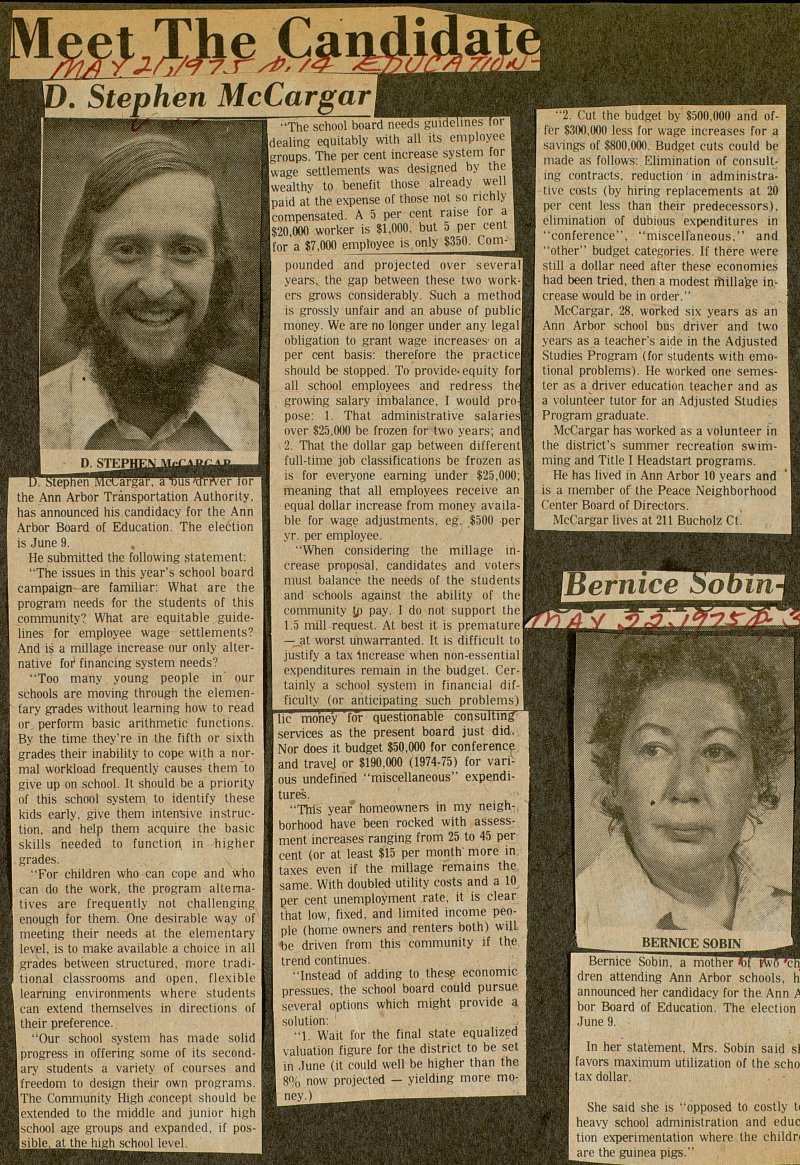Meet The Candidate

D. stephen ivicargar, a tuis 'ariver tor i the Ann Arbor Transportation Authority, has announced his candidacy for the Ann Arbor Board of Education. The election is June 9. He submitted the following statement: "The issues in this year's school board are familiar: What are the program needs for the students of this community?. What are equitable guidelines for employee wage settlements? And is a millage increase our only alternative foi financing system needs? "Too many young people in our schools are moving through the elementary grades without learning how to rèad or, perform basic arithmetic functions. By the time they're in the fifth or sixth grades their inability to cope with a normal workload frequently causes them to give up on school. It should be a priority of this school system to identify these kids early, give them intensive instruction, and help them acquire the basic skills heeded to function, in higher I grades. "For children who can cope and who I can do the work, the program alternaI tives are frequently not challenging I enough for them. One desirable way of I meeting their needs at the elementary I level, is to make available a choice in all I grades between structured, more tradiI tional classrooms and open, flexible l learning environments where students I can extend themselves in directions of I their preference. I "Our school system has made solid Iprogress in offering some of its secondlary students a variety of courses and Bfreedom to design their own programs. ËThe Community High .concept should be Bextended to the middle and junior high Bschool age groups and expanded, if posBsibleaUheJiigh school level. "The school board needs guidelines tor dealing equitably with all its employee I jgroups. The per cent increase system for I wage settlements was designed by the I wealthy to benefit those already well I paid at the expense of those not so richly I compensated. A 5 per cent raise for a I $20,000 worker is $1,000, but 5 per cent I for a $7,000 employee is.only $350. pounded and projected over severall years, the gap between these two work-l ers grows considerably. Such a methodl is grossly unfair and an abuse of publicl money. We are no longer under any legal I obligation to grant wage on al per cent basis: therefore the practicel should be stopped. To provide-equity forl all school employees and redress thel growing salary irnbalance, I would pro-l pose: 1. That administrative salariesl over $25,000 be frozen for two years; andl 2. That the dollar gap between different! full-time job classifications be frozen asi is for everyone earning under $25,000; I meaning that all employees receive an I equal dollar increase from money 1 ble for wage adjustments, eg. $500 peri yr. per employee. I "When considering the millage 1 crease proposal, candidates and votersl must balance the needs of the studentsl and schools agaihst the ability of thel community jp pay. I do not support thel 1.5 mili request. At best it is premature! - _at worst unwarranted. It is difficult tol justify a tax increase when non-essentiall expenditures remain in the budget. Cer-I tainly a school system in financial dif-l ficulty (or anticipating such problems) lic mohe'y "fo"r questionable consulting" services as the present board just did. Nor does it budget $50,000 for conference and travej or $190,000 (1974-75) for various undefined "miscellaneous" expenditures. "This year" homeowners in my neighborhood have been rocked with assessment increases ranging from 25 to 45 per cent (or at least $15 per monttr more in taxes even if the millage remains the same. With doubled utility costs and a 10 per cent unemployment rate, it is clear i that low, fixed, and limited income people (home owners and renters both) wilt I be driven from this community if the trend continúes. "Instead of adding to these economie pressues, the school board could pursue several options which might provide a solution: ' "1. Wait for the final state equalized valuation figure for the district to be set I in June (it could well be higher than the I 8% now projected - yielding more moI ney.) ' "2. Cut the budget by $500,000 and 1 I fer $300,000 less for wage increases for a I I savings of $800,000. Budget cuts could be I I made as follows: Elimination of consult: I [ing contracts, reduction in administraI tive costs (by hiring replacements at 20 I I per cent less than their predecessors), I I elimination of dübious expenditures in I "conference", "miscellaneous." and I I "other" budget categories. If there were I still a dollar need after these economies I had been tried, then a modest rtiillage I crease would be in order." McCargar, 28, worked six years as an I Ann Arbor school bus driver and two I years asa teacher's aide in the Adjusted I Studies Program (for students with I tional problems). He worked one I ter as a driver education teacher and as I a volunteer tutor for an Adjusted Studies Program gradúate. McCargar has worked as a volunteer in the district's summer recreation swimming and Title I Headstart programs. He has lived in Ann Arbor 10 years and is a member of the Peace Neighborhood Center Board of Directors. McCargar lives at 211 Bucholz Ct' 1- -